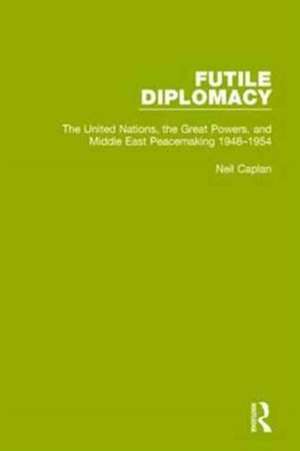Futile Diplomacy, Volume 3: The United Nations, the Great Powers and Middle East Peacemaking, 1948-1954: Futile Diplomacy
Autor Neil Caplanen Limba Engleză Paperback – 10 noi 2016
| Toate formatele și edițiile | Preț | Express |
|---|---|---|
| Paperback (1) | 396.40 lei 6-8 săpt. | |
| Taylor & Francis – 10 noi 2016 | 396.40 lei 6-8 săpt. | |
| Hardback (1) | 1280.44 lei 6-8 săpt. | |
| Taylor & Francis – 13 mai 2015 | 1280.44 lei 6-8 săpt. |
Preț: 396.40 lei
Nou
Puncte Express: 595
Preț estimativ în valută:
75.85€ • 79.62$ • 62.96£
75.85€ • 79.62$ • 62.96£
Carte tipărită la comandă
Livrare economică 10-24 aprilie
Preluare comenzi: 021 569.72.76
Specificații
ISBN-13: 9781138907546
ISBN-10: 1138907545
Pagini: 418
Dimensiuni: 156 x 234 x 22 mm
Greutate: 0.61 kg
Ediția:1
Editura: Taylor & Francis
Colecția Routledge
Seria Futile Diplomacy
Locul publicării:Oxford, United Kingdom
ISBN-10: 1138907545
Pagini: 418
Dimensiuni: 156 x 234 x 22 mm
Greutate: 0.61 kg
Ediția:1
Editura: Taylor & Francis
Colecția Routledge
Seria Futile Diplomacy
Locul publicării:Oxford, United Kingdom
Public țintă
Postgraduate and UndergraduateCuprins
1. Historical and Psychological Context 1.1. Lessons from the Mandate Period 1.2. Changing Structure and Dynamics of the Post-1948 Conflict 1.3. Forms of Third-Party Intervention in the Arab-Israeli Dispute 1.4. The Maze of Mutual Perceptions and Misconceptions 2. War and Mediation, 1948 2.1. Bernadotte's 'Suggestions', 27 June 1948 2.2. Direct Negotiations 2.3. The Bernadotte Plan, September 1948: Acquiescence versus Agreement 2.4. Patterns and Precedents 3. Egypt and Israel at Rhodes 3.1. United Nations Peacemaking: Two Tracks 3.2. From Truce to Armistice 3.3. Getting to the Table 3.4. Opening of Talks 3.5. Breakthrough: Signing the Armistice Agreement 3.6. From Armistice to Peace? 4. The Lausanne Conference: Prenegotiation 4.1. The Palestine Conciliation Commission 4.2. Preparing the Ground 4.3. Shuttle Diplomacy 4.4. Quest for an Advance Gesture from Israel 4.5. PCC Beirut Conference, March 1949 4.6. Continuing Pressure for an Israeli Gesture 4.7. The Shadow of Rhodes 4.8. Strains in the Arab Common Front 5. Manoeuvring at Lausanne 5.1. Opening the Conference 5.2. A Basis for Discussion: The Lausanne Protocol, 12 May 1949 5.3. Staking out the Positions: The First Deadlock 5.4. Israel's Offer to Incorporate the Gaza Strip 6. Lausanne: The Final Stalemate 6.1. July Recess 6.2. Resumption of the Conference 6.3. Israel's Offer to Repatriate 100,000 Refugees 6.4. Continued Conciliation or Imposed Settlement? 6.5. Winding up the Conference 6.6. Lausanne Postcripts 7. Geneva Interlude 7.1. Years of Drift 7.2. From Conciliation to Mediation? 7.3. Bilateral Negotiations 7.4. PCC Geneva Meetings, January-July 1950 8. Deterioration of the Armistice 8.1. From Negative Peace to Positive Peace? 8.2. Beginnings of the Arms Race 8.3. Regional Stability and Arms Control: The Tripartite Declaration, May 1950 8.4. The Entrenchment of Israeli and Arab Positions 8.5. Piecemeal Approaches: 'Knitting Tissue' over the Wound 9. PCC Paris Conference, Autumn 1951 9.1. From Atrophy to Activity: Ely Palmer, the State Department, and the PCC Initiative 9.2. Preparing the Conference 9.3. The Conference Begins 9.4. The PCC's Comprehensive Pattern of Proposal 10. The Paris Conference and the Demise of PCC Mediation 10.1. Draft Non-Aggression Formulae 10.2. From Preamble to Proposals 10.3. Paris Deadlock and the General Assembly 10.4. The Final Sessions: 14 November 1951 10.5. The Demise of the PCC and United Nations Mediation 11. The United Nations and Direct Negotiations, 1952-53 11.1. The Seventh General Assembly (1952): Eight-Power Draft Resolution 11.2. Changes during 1953: Qibiya and Israeli-Jordanian Tensions 11.3. The Israeli Call for Direct Negotiations: November 1953 12. The United Nations Conference that Never Was, 1953-54 12.1. Invoking Article XII: The First Stages 12.2. Arab Reactions to International Pressure 12.3. Responses to Jordan's Refusal Aftermath 13. Conclusion 13.1. Assessment of the Arab-Israeli Impasse 13.2. Approaches to Conflict Resolution 13.3. American Leverage on the Parties 13.4. Techniques of Conciliation 13.5. The Attitudes and Positions of the Parties 13.6. From War to War 14. Documents
Descriere
This book, first published in 1997, provides a careful and balanced behind-the-scenes account of the intricate diplomatic activity of the period between the first and second Arab-Israeli wars. The author examines the recurring deadlocks in terms of the motives and calculations of the various parties, and reveals how new incentives of pressures offered by outsiders proved incapable of reversing the serious deterioration of Arab-Israeli relations as the region headed for war at Suez. The text of this volume comprises both an in-depth analysis of the period and events, and a selection of primary documents from archival sources.





